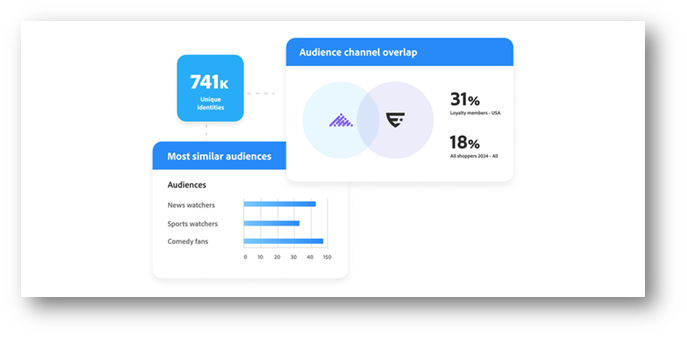As cookies disappear, the need for data collaboration is here
March 29, 2024This article was originally published on Adobe website. Click here to see the original blog post.
Virtually every company is finding that when it comes to customer engagement, acquisition, and loyalty, experience is the difference. Delivering the sort of meaningful, personalized customer experiences that truly break through requires brands to have a deep understanding of their customers’ wants, needs, interests, and expectations. The best brands are those able to anticipate customer behavior so they can tailor and target the freshest, most relevant content to their needs — a level of deep understanding that requires lots of data.
Until recently, brands tended to get that data from information they gather themselves — first-party data — and data gathered by partners through third-party cookies. But the days of third-party cookies are coming to an end. Google Chrome, currently used for roughly two-thirds of all web browsing, will say goodbye to third-party tracking cookies this year. Other browsers, including Mozilla’s Firefox and Apple’s Safari, already block third-party cookies by default.
If you’re a marketer, get ready: The ways you’ve previously worked will no longer serve you. To get a more holistic view of your customers, first-party data is critical, as are third-party data providers. Data assembled by other brands — also known as second-party data — can provide a more complete view of your customers. Adopting a data collaboration strategy, and assembling working relationships with media partners, is key in the cookieless era.
With the rise of retail media and connected TV, the world of digital media is even more focused on addressable audiences. Today’s marketers need to make the most of their first-party data to understand and engage with their customers impactfully, but they also need the ability to find and acquire new customers for whom they don’t have first-party data yet. This is why having the ability to safely collaborate with partners and access second- and third-party durable data is critical. In other words, brands are going to need to rethink their strategies to develop a deeper understanding of their current and future customers through these new privacy-focused collaborations.
New challenges for the cookieless era
Without the right data and solutions, marketers will struggle to grow customer relationships and their bottom lines. At a time when many companies are trying to rebuild their acquisition strategies and comply with regulations, brands and publishers will rely upon trustworthy solutions to collaboratively prospect, remarket, and measure effectiveness — without sharing underlying customer data with each other. In the post-cookie world, brands will also need these solutions to reach consumers across new and emerging channels, such as personalized ads streamed through connected TVs and car audio systems.
Data collaboration and data clean room technologies have emerged to address the need for connected cookieless experiences, but historically, these technologies have required advanced and expensive technical resources. For example, CIOs must configure data clean rooms in data warehouses and build connections to collaborating parties before beginning to field inbound requests from eager marketers. Some vendors also require identity verification before data collaboration, so as each party selects its own technology stacks, the lack of interoperability further fragments collaboration.
Siloing data and tools also creates disconnects in the customer experience, and of course, privacy and consent remain key concerns every time audience data is shared.
Addressing brands’ pain points
To dramatically simplify the way marketers use data to discover, reach, and measure audiences in the cookieless era, Adobe has built a solution — Real-Time Customer Data Platform (CDP) Collaboration. We built Collaboration to be marketer-friendly, easy-to-use, and built for scale, addressing audiences on new and emerging channels while enabling publishers to interact with brand partners in one place.
Publishers and brands need to work together regardless of the technology stack either party wants to employ. Historically, that’s been a challenge for CIOs and CMOs. IT leaders will particularly appreciate that Collaboration is agnostic and interoperable, playing well with cloud data warehouses, walled gardens, and partners ranging from identity and measurement to other brands. Critically, our solution maintains the highest levels of privacy and security for data, while including controls to ensure users can collaborate without sharing underlying data or exposing audience information without consent.

Connecting teams and addressing important channels
In the post-cookie world, brand advertisers need to continue to demonstrate business value, from prospecting for new audiences, re-engaging them to convert, suppressing converted audiences, and measuring the impact of their ad dollars. Similarly, publishers need to drive value for their business and adopt efficient technologies to scale growth. Today, each of these workflows tends to happen in separate systems and sometimes also in separate teams. Within Collaboration, these key brand and publisher workflows can come together:
- To discover audiences, brands can use dashboards and workflows to view publisher audiences in order to prospect and uncover audience overlaps by identity type
- To reach audiences, brands can work with publishers and identity partners to execute campaigns across connected TV, audio, walled gardens, demand-side platforms, and other destinations of choice
- To measure return on media spend, brands can use dashboards and workflows to understand campaign performance and opt-in in order to combine conversion data with publisher ad exposure data to close the loop
Moving beyond third-party cookies is a journey, not a destination: Businesses continue to grow their first-party data strategies and systems over time. As they mature, they will need to add and change data partnerships with publishers, other brands, identity providers, and measurement partners. Adobe Real-Time CDP already offers capabilities to work with partner data, alongside first-party data, in the same system. Real-Time CDP Collaboration supercharges the value of first-party data by extending it across more channels and platforms while honoring consumer consent and preferences. With connectivity to Adobe Mix Modeler, Customer Journey Analytics, and more, brands can centrally deliver and measure great experiences with a trusted ecosystem of connected tools.
As challenging as the transition from third-party cookie dependence to first-party data building may be, collaboration with partners — together within a trustworthy, easy-to-use system that connects brands, publishers, and data partners — will be critical for customer acquisition during a period of industry change, especially across new and emerging channels.
To learn more about how you can prepare for the post-cookie world, visit the Adobe Collaboration Hub page.


